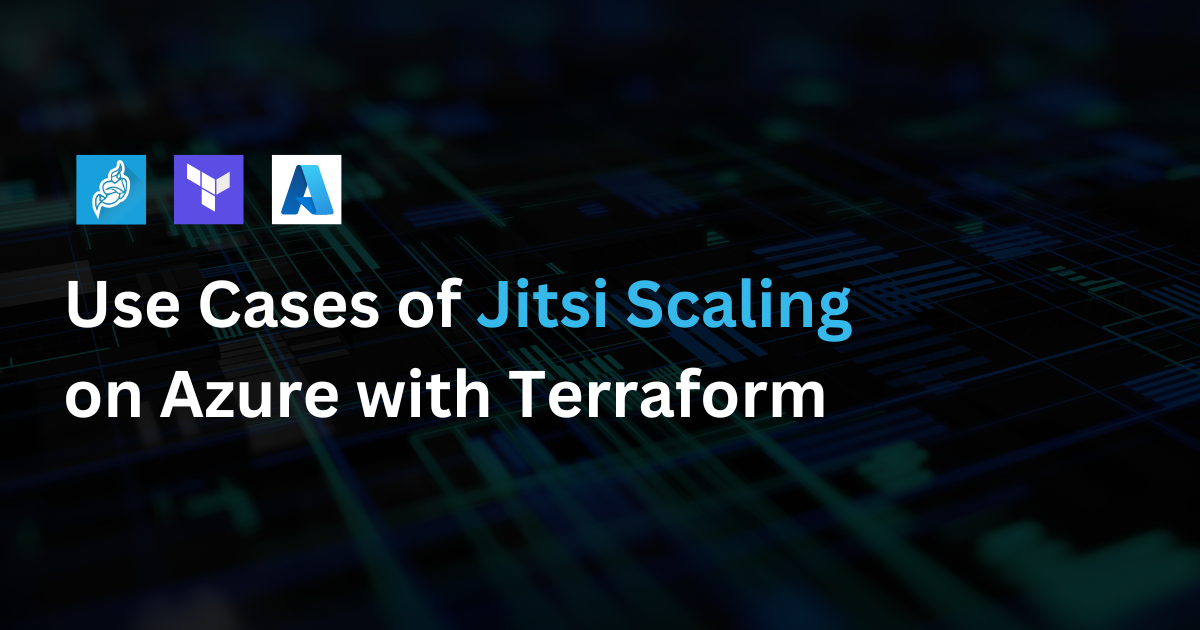Table of Contents
- Introduction
- The Challenge: Jitsi’s Architecture and Scalability Limits
- The Solution: Scaling Jitsi Using Terraform on Azure
- Step-by-Step: How Terraform Automates Jitsi Scaling on Azure
- Benefits of Scaling Jitsi Meet with Terraform on Azure
- Real-Life Example: Scaling Jitsi for an Online Learning Platform
- Conclusion
Introduction
Have you ever wondered how to scale your Jitsi Meet infrastructure for thousands of real-time video calls without compromising performance? If you’re running Jitsi in production, especially on a cloud platform like Azure, you’ll quickly hit limits unless you implement a solid scaling strategy.
In this blog, you’ll learn about a practical use case of Jitsi scaling using Terraform on Azure — a powerful combination to streamline and automate your Jitsi Meet deployment. You’ll also explore the core concepts of Jitsi server scaling, how to overcome infrastructure limitations, and why scaling Jitsi Meet the right way is critical to delivering a reliable video conferencing experience.
The Challenge: Jitsi’s Architecture and Scalability Limits
Jitsi’s architecture includes multiple components:
- Jitsi Meet (Frontend/UI)
- Jicofo (conference focus)
- JVB (media bridge)
- Prosody (XMPP server)
The JVB is the key scaling point. It’s responsible for routing media streams. By default, one JVB handles a limited number of simultaneous streams. When that limit is breached, performance degrades fast.
That’s why most Jitsi scalability strategies rely on horizontal scaling — adding more JVBs based on demand. But doing this manually? Not ideal.
The Solution: Scaling Jitsi Using Terraform on Azure
To address this, you can automate infrastructure provisioning using Terraform scripts. With Azure as your cloud provider, Terraform lets you deploy and manage a scalable Jitsi environment — with repeatable, version-controlled infrastructure.
Here’s a common use case of Jitsi scaling using Terraform on Azure:
- Automated JVB Deployment: When call load increases, Terraform provisions new Azure VMs with JVB pre-installed.
- Elastic Scaling: You can set up Azure VM scale sets or custom logic that triggers horizontal scaling based on metrics like CPU or bandwidth.
- Network Optimization: Load balancers are automatically configured to route users to the nearest or least loaded JVB.
- Centralized Configuration: All infrastructure settings, such as VM specs, storage, and network rules, are stored in Terraform files, reducing human error.
This approach ensures a consistent deployment strategy while maintaining high availability for your real-time video communications.
Step-by-Step: How Terraform Automates Jitsi Scaling on Azure
Let’s walk through what this setup typically involves:
-
Define Infrastructure in Terraform
Create.tffiles that declare your VMs, VNet, NSGs, Load Balancer, and Jitsi components. -
Use Azure VM Scale Sets for JVBs
Deploy JVBs as part of a scale set that auto-increases or decreases based on traffic metrics. -
Bootstrap JVBs with Cloud-Init or Scripts
Use provisioning scripts to install and configure JVB on new instances. -
Register JVBs Dynamically with Jicofo
Configure each JVB to auto-register with Jicofo upon launch, so they’re instantly available for routing calls. -
Monitor and Adjust
Use Azure Monitor or Prometheus/Grafana stack to analyze load patterns and adjust scaling thresholds.
By implementing these steps, you’re enabling scaling Jitsi Meet based on real-time demand — saving cost and preventing performance drops.
Read this also: Step-by-Step Guide Jitsi Scaling with Terraform on Azure
Benefits of Scaling Jitsi Meet with Terraform on Azure
- Cost Efficiency: Scale only when needed. Avoid overprovisioning resources.
- High Availability: More JVBs = better redundancy and reliability.
- Automation: Reduce manual configuration errors and speed up deployments.
- Flexibility: Easily replicate infrastructure across regions or test environments.
- Real-time Communication Scaling: Support more concurrent meetings without losing video/audio quality.
If you’re deploying a SaaS product or internal communications platform, this setup ensures that your video conferencing server architecture can handle the load — whether it’s 50 or 5,000 users.
Real-Life Example: Scaling Jitsi for an Online Learning Platform
Let’s say you’re running an online learning platform for schools. During peak hours, hundreds of classrooms go live. You initially deployed 2 JVBs, but now you’re seeing call drops and lags.
Using Terraform, you automate scaling rules on Azure:
- When CPU hits 70% on current JVBs, spin up 2 more.
- Configure autoscaling to a max of 10 JVBs during school hours.
- Off-peak hours? Automatically scale back to 2 to save cost.
This is a practical use case of Jitsi scaling that proves valuable for real-time learning environments, ensuring uninterrupted classes and smooth video delivery.
Conclusion
When it comes to real-time video communication, scaling Jitsi Meet properly can make or break your platform’s performance. Using Terraform scripts on Azure, you can automate and optimize the entire scaling process — achieving a robust, flexible infrastructure that adjusts to your users’ needs.
Whether you’re managing corporate video calls, telehealth appointments, or virtual classrooms, understanding the use case of Jitsi scaling gives you the edge in delivering a top-notch user experience.
Looking to implement this for your organization or project? Start by defining your Jitsi architecture, set up Terraform for Azure, and unlock the full potential of Jitsi scalability strategies.
FAQ
Horizontally scaling Jitsi servers is ideal for large virtual events, remote team collaboration tools, telemedicine platforms, and online education — anywhere that requires concurrent video sessions with consistent quality.
Yes. Terraform supports AWS, Google Cloud, and many others. The principles of Jitsi scaling remain the same; only the cloud-specific resources differ.
Yes, as long as your JVBs are properly registered and monitored, autoscaling improves reliability by balancing load dynamically without downtime.
You can start with 1 Jitsi Meet frontend, 1 Jicofo, 1 Prosody, and 2 JVBs in a scale set. From there, you can simulate load and expand based on usage.



